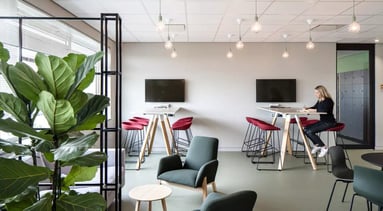Designing your workplace with neurodiversity in mind

In a recent Fast Company article, Claire Shepherd shares why leaders need to ditch the one-size-fits-all-brains approach to office design and rethink office norms that will benefit everyone.
Understanding the neurodiverse workforce
For the workplace to do its job, first, organizations need to recognize a range of neurodivergent conditions exist within the workforce such as autism, ADHD, dyslexia, etc. Their cognitive experiences often differ from others, space included.
“15 to 20% of the world’s population is comprised of neuro-minorities, yet you’ll almost never hear it mentioned in diversity, equity, and inclusion programs. We need to change that now, particularly with the ‘great return’ to the office.” – Claire Shepherd, Chief Operating Officer
As companies encourage their people to come back into the office, adapting the workplace to support everyone needs to be a top priority. By embedding DEIB practices into workplace strategy and taking purposeful action to create inclusive and welcoming work environments for all, organizations can put a premium on belonging and ensure their workforce is in a space where they can thrive.
Five office design considerations:
- Provide different space options
One way to accommodate the many ways people do their best work is to offer a menu of intentional spaces – including quiet areas for focus work, higher-stimuli settings for collaboration and socializing, and recharging stations for respite. Be thoughtful about design features like glass walls, lighting, colors, acoustics, and other sensory elements. - Consider aesthetics
Incorporating more natural light throughout the workspace can support mental health and wellbeing. In the absence of access to natural light, use design features like mirrors, shiny furniture, greenery, adjustable lighting, and soft color palettes. - Prioritize air quality
Invest in HVAC equipment and maintenance to facilitate healthy air quality and circulation to limit any intrusive smells. For workers with hyper-sensitivity to smell, troublesome smells can cause anxiety or even depression. - Be strategic about furniture and placement
Help employees feel more at home in the workplace by assessing and testing the textures of furniture. Arranging furniture in different ways can also help staff feel more equipped to do their work. For example, set up workstations and other spaces in different ways – facing away from each other, towards a window, etc. - Create easy wayfinding and layouts
It's easy to get lost in an office where everything looks the same. By creating more unique spaces with visual landmarks, staff can map their travel paths and save time and frustration navigating through the workplace.
At the end of the day, the workplace should be designed to support all staff, whether you have a neurogenetic condition or not. Supporting your workforce can lead to better talent attraction and retention, create a better culture, and positively impact your bottom line.
Check out more insights from Unispace about supporting neurodiversity.


